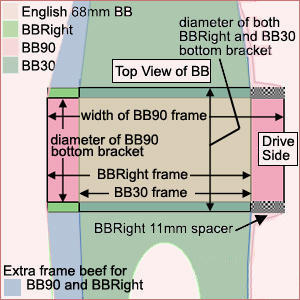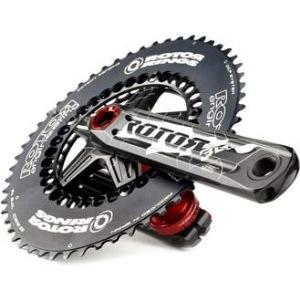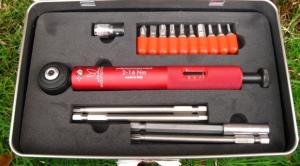For some odd reason, the aero cranks and chainrings are fleeting items in the world of triathlon equipment. They can’t seem to stick around for much longer than a few years. Shimano had an aero chainring for their 9-speed systems, but haven’t featured one since. Zipp’s VumaChrono carbon crank was discontinued. Perhaps the steadiest offering in recent years has come from Rotor, who makes an aero crank spider (130mm bolt circle diameter) and chainrings - both round and oval - in 110 and 130mm BCD.
The subject of today’s article is FSA and their Vision brand. Formerly known as Vision Tech, this brand-within-a-brand handles the aerodynamic side of things for FSA – including aero cranks and chainrings. Over the past decade or so, they have offered a few different TT ‘rings and cranks, under names like Krono and Trimax.
Today we are reviewing their newest iteration, called the Metron. Our experience so far says that it’s the best TT crank they’ve ever produced, so we hope it sticks around to break the cycle of short life spans.

To kick things off, let’s have a look at the basic specs.
Vision Metron BB386EVO crank specifications:
MSRP: $849.99
Weight: 730 grams
Length options: 155, 160, 165, 170, 172.5, 175, 177.5, 180mm
Spindle diameter: 30mm
Bottom bracket compatibility: BB386EVO
Chain compatibility: 10 and 11-speed Shimano/SRAM/Campagnolo
Q-factor: 145mm
Bolt Circle Diameter (BCD): 130mm, 5 bolt
Chainring sizes: 53/39
Aftermarket ring options: 53/39, 54/42, 55/42
As you can see, this crank is made for the newest BB standard (that we’re aware of) – BB386EVO. A joint effort by FSA and bike manufacturer, BH, it is a new take on the 30mm diameter spindle.

What the heck is BB386EVO? I’ll do my best to keep it as simple as possible with a brief history.
English-threaded BSA bottom bracket shells are 68mm wide. They work with threaded bottom brackets, which can house the bearings inside of the shell or in outboard cups. Most modern threaded systems use outboard cups and a 24mm crank spindle in these bottom bracket shells. A second similar option uses the same style of crank, but with a Press Fit cup in the frame, called BB86. It’s 86.5mm wide.
The industry decided that wasn’t good enough, so we made the shells even larger in diameter to accommodate a 30mm aluminum crank spindle. The shell remained at 68mm wide, and the bearings press in to the frame directly without any sort of cup around it. That's called BB30.
SRAM took BB30 one step further and simplified it with a nylon cup around the bearing, called PressFit 30. The shell remains at 68mm wide. This system reduces frame cost compared to BB30.
Cervelo opted to evolve PressFit 30 into a system called BBRight, which makes the frame 11mm wider – but ONLY on the non-drive side, so the frame is asymmetric. This is intended to improve frame stiffness where possible (on the left side of the bike), but retain chainring and crank spider stiffness on the drive side / right side.
Finally, FSA and BH have taken the final step in width, making the drive side as wide as possible (the shell is symmetrical). Total bottom bracket width is 86.5mm, the same as BB86 mentioned above. The required crank spindle is 18.5mm longer than a standard BB30/PF30 crank.

Why BB386EVO? In short, I’m told that FSA wanted something that packed all of the same features as BB30, but would also be compatible with – conceivably – every bike out there. With a long spindle, all you need is the right adapter or shim to make it work. As of today, we’re aware of adapters to fit these cranks in everything except Cervelo BBright frames and Trek BB90 frames. Here are the options and prices from FSA:
MEGAEVO threaded BB – Ceramic: $225, 88 grams
MEGOEVO threaded BB – Steel: $55, 88 grams
BB30/PF30 – Ceramic: $200, 76 grams
BB30/PF30 – Steel: $50, 76 grams
Adaptors to fit EVO crank into BB30/PF30: $20
BB86 -386EVO steel BB: $55 (allows the use of 386 cranks in BB86 frames)
Put another way, you can use a BB368 crank in a BB30 frame because the spindle is longer-than-necessary (just use a shim to take up the extra width). You cannot, however, use a BB30 crank in a BB386 frame, because the spindle is too short. According to FSA’s Ron Correa, these manufacturers currently offer BB386EVO-specific frames:
-BH
-Litespeed / Quintana Roo
-Wilier
-Jamis
-Opus
-Volagi
Confused? Don’t worry about it. The take-home for right now is that – unless you own a top-end Trek or Cervelo with their own bottom bracket systems – you can use this crank. If your Trek or Cervelo has an industry standard BB86 (lower-end Speed Concept) or threaded BB shell (P2C), you’re good.
My personal stable of bikes tends to be a revolving door of different parts. I opted to install this crankset on my Habanero travel bike with S&S Couplers (it just happened to be the bike that was available at the time). It features a threaded bottom bracket shell, so FSA sent the appropriate bottom bracket to me.

Take note: Make sure that the bearings have grease underneath the secondary outer seals (orange part). Also be sure to grease the crank spindle and inner bearing races. FSA provides a syringe of their own special grease with the bottom bracket:

The MegaEVO threaded bottom brackets require FSA’s large-diameter wrench (not the same as a Shimano/SRAM outboard bearing wrench):

The huge crank bolt is integrated into the left arm.

The proper torque specification is 38-41 Newton meters. I used my Effetto Mariposa Giustaforza 10-60 torque wrench and 10mm hex socket to do the job.

As you can see, the profile of the crankarm is very slim:

With everything buttoned up, my bike looks cooler than it it ever has. FSA also sent a pair of their Metron wheels, which we will review separately:

Perhaps the most important aspect of the new Metron crank is the fact that FSA is now finally serious about shorter crank options that are so popular today in triathlon. My normal crank length for my tri bike is 165mm, but the Metron is available down to 155mm.

While we get a lot of wonderful options in lengths, there is unfortunately only one option in bolt circle diameter – 130mm. The smallest TT chainring size from FSA is 53/39. That is fine with me in the flatlands of Michigan, but we see more and more triathletes moving to smaller 52/36 and 50/34 rings.

The good news about those rings is that they shift wonderfully. I owned an original generation aluminum 135mm BCD FSA aero chainring about ten years ago, and, well… it shifted like crap. It was really bad. I actually only kept the ring on for one day, because it would clunk, chatter, and drop chains all over the place.
Thankfully, these new rings are the polar opposite. With an Ultegra 6700 front derailleur and Dura Ace 7900 10-speed chain, I had fast shifting and zero dropped chains. The rings feel very substantial with no perceptible flex.

As you can see in the above photo, the chainrings and crank are two separate pieces. FSA gets a huge pat on the back for actually staying with one of the few remaining industry standards – the 5 bolt chainring and crank. No hidden bolts, no proprietary rings, and no nonsense.
The crank bolts are T30 Torx on one side and 6mm hex on the other.

Even the back of the crank is ‘aero’ and filled in with a smooth surface.

What is the aero advantage of the Metron crank? Unfortunately, FSA was not able to provide any definitive information yet. I have actually never seen any wind tunnel data that controlled specifically for TT cranks and rings. My guess is that there is either no improvement outside of the test’s margin of error or, perhaps more likely, there is not enough sales volume behind TT cranks to actually warrant paying for the test. Let’s be honest, too – most people buy aero cranks and rings because of how they look.
Function and Riding
As mentioned above, the shifting of FSA’s latest TT chainring is an enormous improvement over past designs. Overall, the crank installation and basic function was uneventful.
I did notice that the crank did not spin as long as my other bikes with no chain installed. With new bearings and everything installed exactly as the instructions state, the cranks would go 1 – 1.5 revolutions with a ‘hard’ spin. After a few weeks of riding, I removed the chain to see if anything improved, and it was up to 2 – 2.5 revolutions. The only real consequence is that backpedaling quickly causes the chain to go slack and contact the top of the right chainstay. I plan to leave the cranks on for the foreseeable future, and am curious to see if it changes. I also wonder if our impending cold winter weather is adding to the behavior (I have been riding it in temperatures of about 25 – 50 degrees Fahrenheit).
For better or worse, this is what I have come to expect from all modern cranks with 30mm spindles, be it BB30, PF30, or anything else. What I don’t know is if there is any measurable cost in rider wattage once the system is loaded and your legs are moving. Ceramic bottom brackets tend to spin better, in part because they typically use non-contact seals and/or thin grease. With such a large bearing seal, contact area and drag are necessarily higher than cranks and bearings of smaller diameter.

Are these cranks for you? As previously mentioned, bottom bracket standards continue to multiply every year. The good news is that anything with a long spindle (like BB386EVO) has a better chance of being supported in the future by more frames and bottom bracket adapters. Because I’m a scrooge, I’d personally prefer this crank with a standard 24mm spindle, but I understand why FSA made the decision that they did.
If you are in the market for an aero crank, I think the Metron deserves to be on your list, especially if you want a ‘short’ crank length and standard chainring sizes.




